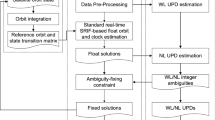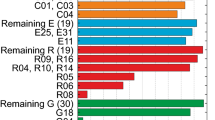Abstract
Low earth orbit satellites (LEOs) play an important role in communications, Earth observation and other applications. The real-time precise orbit determination (RTPOD) of LEOs plays an important role. However, the quality of carrier observations must be strictly controlled for the RTPOD of LEO satellites. Nevertheless, the ionospheric residual (IR) calculated from dual-frequency carrier observations at low sampling rates varies greatly due to the high speed of LEO satellites, and adopting the existing quality control method constrains the RTPOD performance in the highly dynamic environment. We present a new quality control for the receiver clock offset (QCCLK) algorithm, which combines LEO satellites' dynamic models with GNSS observations to detect carrier observation anomalies. Based on the QCCLK algorithm, real-time multi-GNSS automatic precise orbit determination (RTMG-APOD) software is designed. For comparison, we study the IR distribution at different sampling rates, revealing that the IR algorithm is not suitable for the quality control of LEO observations. RTMG-APOD software is used to analyze the RTPOD performance of the GFZ multi-GNSS final product (GBM), CNES real-time product (CNT) and IGS real-time service (RTS) product on GRACE Follow-On Level-1A observations. The RTPOD experiment results demonstrate that the 3D RMS of the GBM product is approximately 8 cm, and that of the CNT and RTS products is approximately 10 cm. Finally, an RTPOD experiment with one month of observations at different sampling rates using the GBM product and CNT real-time ephemeris verifies the stability of the QCCLK algorithm and its applicability to devices with low sampling rates.








Similar content being viewed by others
Data availability
In this paper, we use the GRACE-FO Level-1A spaceborne GPS dual-frequency observations provided by GFZ, the GRACE-FO precise orbit released provided by JPL (ftp://isdcftp.gfz-potsdam.de/grace-fo/), the broadcast ephemeris provided by CDDIS (https://cddis.nasa.gov/archive/gps/data/daily/), the GBM precise orbit and clock offset product provided by GFZ (ftp://ftp.gfz-potsdam.de//pub/home/GNSS/products/mgex/), the CNT real-time ephemeris provided by CNES (ftp://ppp-wizard.net//PRODUCTS/REAL_TIME/), and real-time service (RTS) can be saved by BNC software (https://igs.bkg.bund.de/ntrip/bnc).
References
Bertiger W, Desai SD, Dorsey A, Haines BJ, Harvey N, Kuang D, Sibthorpe A, Weiss JP (2010) Sub-centimeter precision orbit determination with GPS for ocean altimetry. Mar Geod 33(S1):363–378. https://doi.org/10.1080/01490419.2010.487800
Blewitt G (1990) An automatic editing algorithm for GPS data. Geophys Res Lett 17(3):199–202. https://doi.org/10.1029/GL017i003p00199
Capitaine N, Gambis D, McCarthy D, Petit G, Ray J, Richter B, Rothacher M, Standish M, Vondrak J (eds) (2002) IERS technical note 29 proceedings of the IERS workshop on the implementation of the new IAU resolutions 2002. Verlag des Bundesamts für Kartographie und Geodasie, Frankfurt am Main
Elsobeiey M, Al-Harbi S (2016) Performance of real-time precise point positioning using IGS real-time service. GPS Solut 20(3):565–571. https://doi.org/10.1007/s10291-015-0467-z
Feng Y (2001) An alternative orbit integration algorithm for GPS-based precise LEO autonomous navigation. GPS Solut 5:1–11. https://doi.org/10.1007/PL00012882
Hadas T, Bosy J (2015) IGS RTS precise orbits and clocks verification and quality degradation over time. GPS Solut 19(1):93–105. https://doi.org/10.1007/s10291-014-0369-5
Hadas T et al (2017) Impact and implementation of higher-order ionospheric effects on precise GNSS applications. J Geophys Res Solid Earth 122(11):9420–9436. https://doi.org/10.1002/2017JB014750
Hatch R (1982) The synergism of GPS code and carrier measurements. In: Proceeding of third international symposium on satellite doppler positioning physical science laboratory, New Mexico Stat University, vol 2, pp 1213–1231
Hatch R (2006) A new three-frequency, geometry-free, technique for ambiguity resolution. In: Proceeding of ION GNSS, 26–29 September, Fort Worth, TX, pp 309–316
Hatten N, Russell RP (2017) A smooth and robust Harris–Priester atmospheric density model for low Earth orbit applications. Adv Space Res 59(2):571–586. https://doi.org/10.1016/j.asr.2016.10.015
Hoque MM, Jakowski N (2007) Higher order ionospheric effects in precise GNSS positioning. J Geod 81(4):259–268. https://doi.org/10.1007/s00190-006-0106-0
IGS International GNSS Service (2021) http://www.igs.org/products. Accessed 10 Aug 2021
Jäggi A, Hugentobler U, Beutler G (2006) Pseudo-stochastic orbit modeling techniques for low-Earth orbiters. J Geod 80(1):47–60. https://doi.org/10.1007/s00190-006-0029-9
Kang Z, Bettadpur S, Nagel P, Save H, Poole S, Pie N (2020) GRACE-FO precise orbit determination and gravity recovery. J Geod 94:1–17. https://doi.org/10.1007/s00190-020-01414-3
Kang Z, Tapley B, Bettadpur S, Ries J, Nagel P, Pastor R (2006) Precise orbit determination for the GRACE mission using only GPS data. J Geod 80(6):322–331. https://doi.org/10.1007/s00190-006-0073-5
Kazmierski K, Sośnica K, Hadas T (2018) Quality assessment of multi-GNSS orbits and clocks for real-time precise point positioning. GPS Solut 22(1):1–12. https://doi.org/10.1007/s10291-017-0678-6
Kornfeld RP, Arnold BW, Gross AMA et al (2019) GRACE-FO: The gravity recovery and climate experiment follow-on mission. J Spacecr Rocket 56:931–951. https://doi.org/10.2514/1.A34326
Luzum BJ, Ray JR, Carter MS, Josties FJ (2001) Recent improvements to IERS bulletin a combination and prediction. GPS Solut 4(3):34–40. https://doi.org/10.1007/PL00012853
Mao X, Visser P, van den IJssel J (2019) Absolute and relative orbit determination for the CHAMP/GRACE constellation. Adv Space Res 63(12):3816–3834. https://doi.org/10.1016/j.asr.2019.02.030
Männel B, Brandt A, Nischan T., Brack A, Sakic P, Bradke M (2020) GFZ final product series for the International GNSS Service (IGS). GFZ Data Services. https://doi.org/10.5880/GFZ.1.1.2020.002
Mathews PM, Herring TA, Buffet B (2002) Modeling of nutation-precession: new nutation series for nonrigid Earth, and insights into the Earth’s interior. J Geophys Res. https://doi.org/10.1029/2001jb000390
Montenbruck O, Gill E (2000) Satellite orbits: models, methods and applications. Springer, Heidelberg
Montenbruck O, Ramos-Bosch P (2008) Precision real-time navigation of LEO satellites using global positioning system measurements. GPS Solut 12:187–198. https://doi.org/10.1007/s10291-007-0080-x
Montenbruck O, Andres Y, Bock H, van Helleputte T, van den Ijssel J, Loiselet M, Marquardt C, Silvestrin P, Visser P, Yoon Y (2008) Tracking and orbit determination performance of the GRAS instrument on MetOp-A. GPS Solut 12:289–299. https://doi.org/10.1007/s10291-008-0091-2
Noll CE (2010) The crustal dynamics data information system: a resource to support scientific analysis using space geodesy. Adv Space Res 45(12):1421–1440. https://doi.org/10.1016/j.asr.2010.01.018
Pavlis NK, Holmes SA, Kenyon SC, Factor JK (2012) The development and evaluation of the earth gravitational model 2008 (EGM2008). J Geophys Res Solid Earth. https://doi.org/10.1029/2011JB008916
Petit G, Luzum B (2010) IERS conventions 2010 (IERS Techni-cal Note; 36). Frankfurt am Main: Verlag des Bundesamts für Kartographie und Geodäsie, 2010, p 179. ISBN: 3-89888-989-6
Reichert A, Meehan T, Munson T (2002) Toward decimeter-level real-Time orbit determination:A demonstration using the SAC-C and CHAMP spacecraft. In: Proceedings of ION GNSS, 24–27 September, Portland City, OR
Standish E (1998) JPL planetary and lunar ephemerides DE405/LE405. Interoffice Memorandum IOM 312.F-98-048. Jet Propulsion Laboratory, Pasadena
Marquardt C, Andres Y, von Engeln A, Clerigh EO, Sancho F (2007) GRAS on Metop: data quality. In: Proceedings of second FORMOSAT-3/COSMIC data users workshop, Boulder, Colorado, 22–24 October 2007
Wu JT, Wu SC, Hajj GA, Bertiger WI, Lichten SM (1993) Effects of antenna orientation on GPS carrier phase. Manuscr Geod 18(2):91–98
Wang K, Rothacher M (2013) Ambiguity resolution for triple-frequency geometry-free and ionosphere-free combination tested with real data. J Geod 87(6):539–553. https://doi.org/10.1007/s00190-013-0630-7
Wang F, Gong X, Sang J, Zhang X (2015) A novel method for precise onboard real-time orbit determination with a standalone GPS receiver. Sensors 15(12):30403–30418. https://doi.org/10.3390/s151229805
Wang Z, Li Z, Wang L, Wang X, Yuan H (2018) Assessment of multiple GNSS real-time SSR products from different analysis centers. ISPRS Int J Geo Inf 7(3):85. https://doi.org/10.3390/ijgi7030085
Wen HY, Kruizinga G, Paik M, Landerer F, Bertiger W, Sakumura C, Bandikova T, Mccullough C (2019) Gravity recovery and climate experiment follow-on (GRACE-FO). Level-1 data product user handbook vol JPL D-56935 (URS270772)
Xiao G, Liu G, Ou J, Liu G, Wang S, Guo A (2020) MG-APP: an open-source software for multi-GNSS precise point positioning and application analysis. GPS Solut 24(66):1–13. https://doi.org/10.1007/s10291-020-00976-1
Ye F, Yuan Y, Tan B, Deng Z, Ou J (2019) The preliminary results for five-system ultra-rapid precise orbit determination of the one-step method based on the double-difference observation model. Remote Sens 11(1):46. https://doi.org/10.3390/rs11010046
Ye F, Yuan Y, Deng Z (2020) Improved ultra-rapid UT1-UTC determination and its preliminary impact on GNSS satellite ultra-rapid orbit determination. Remote Sens 12(3584):3584. https://doi.org/10.3390/rs12213584
Zhang L, Yang H, Gao Y, Yao Y, Xu C (2018) Evaluation and analysis of real-time precise orbits and clocks products from different IGS analysis centers. Adv Space Res 61(12):2942–2954. https://doi.org/10.1016/j.asr.2018.03.029
Acknowledgements
We would like to thank the GFZ, CNES, JPL and CDDIS for providing GRACE-FO spaceborne observations and products, and BKG for its BNC software. In addition, we are grateful to Ming Gao, Shengliang Wang, Dong lv, and Xiacheng Li for their help. We also appreciate the reviewers for their valuable suggestions on improving the manuscript. This work is funded by the National Natural Science Foundation of China (Nos. 41974008, 41574015, 41774017, and 41804019) and the National Key Research Programme of China Collaborative Precision Positioning Project (No. 2016YFB0501900).
Author information
Authors and Affiliations
Corresponding authors
Additional information
Publisher's Note
Springer Nature remains neutral with regard to jurisdictional claims in published maps and institutional affiliations.
Appendix
Appendix
In Appendix Algorithm 1, the GNSS error corrections \({\varvec{d}}_{i}\) includes navigation satellite clock offset, phase hardware delays and antenna corrections of the receiver and satellite, Earth rotation corrections, relativistic corrections, etc. The \(\sigma_{r}\) indicates the 3D LEO satellite positioning accuracy after RTPOD convergence, and the value of \(\sigma_{r}\) is generally between 5 and 10 cm when using precise orbit and clock offset product. \(\sigma_{t}\) indicates the maximum deviation of each navigation satellite from the median, which is usually 6–8 cm to detect 1 cycle or 0.5 cycle slip or gross errors. s represent the navigation satellite system,\(d{\varvec{t}}_{r,i}^{s}\) is receiver clock offset vector, \(\Delta t_{r,med}\) is the median of \(\Delta {\varvec{t}}_{{{\varvec{r}},{\varvec{i}}}}^{s}\).

Rights and permissions
About this article
Cite this article
Xiao, G., Liu, G., Ou, J. et al. Real-time carrier observation quality control algorithm for precision orbit determination of LEO satellites. GPS Solut 26, 102 (2022). https://doi.org/10.1007/s10291-022-01286-4
Received:
Accepted:
Published:
DOI: https://doi.org/10.1007/s10291-022-01286-4




